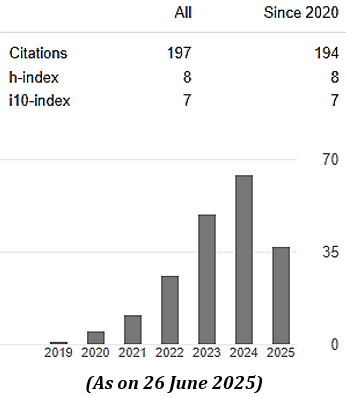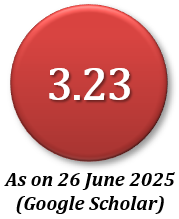Autonomous Braking System: for Automobile Use
Abstract
Road fatality and injury are a worldwide issue in the transportation industry. Road traffic accidents are becoming increasingly significant due to higher mortality, injury, and disability across the world, particularly in developing and transitional economies. Eighty-five percent of the total road traffic fatalities occur in developing nations, with Asia-Pacific accounting for roughly half of them. A variety of factors influence road safety, including technological, physical, social, and cultural factors. The purpose of this research was to design an autonomous braking system (AuBS). Using the Adaptive Neuro-Fuzzy Intelligent System (ANFIS), a DC motor, sensors, and SAuBS have been developed to customize the traditional hydraulic braking system. The genetic algorithm has been developed to simulate the fundamental characteristics of the automotive braking system. The AuBS system goal is to slow the car without the driver's help infrequent braking when the vehicle is moving at slower speeds. When the ANFIS performance is compared to that of the AuBS model, it is discovered that the ANFIS performs roughly 15% better.
Downloads
References
Anbalagan P & Suyambukanni N, “Non-Motorized Transport (with special reference to Bicycles in Chennai City)” Indian Journal of Transport Management, Oct-Dec 2010, Vol. 34(4), pp 273-284.
ASEAN NCAP, “Asean ncap new rating protocols for 2017-2020 - the new car assessment program for southeast asia,” http://aseancap.org, accessed: 2017.08.26.
Berger, D. Block, S. Heeren, C. Hons, S. Kuhnel, A. Leschke, D. Plotnikov, and B. Rumpe, “Simulations on consumer tests: A systematic evaluation approach in an industrial case study,” IEEE Intelligent Transportation Systems Magazine, vol. 7, no. 4, pp. 24–36, 2015.
Breuer, A. Faulhaber, P. Frank, and S. Gleissner, “Realworldsafety benefits of brake assistance systems,” in 20th International Technical Conference on the Enhanced Safety of Vehicles (ESV), no. 07-0103, 2007.
Distner, M. Bengtsson, T. Broberg, and L. Jakobsson, “City safetya system addressing rear-end collisions at low speeds,” in Proc. 21st International Technical Conference on the Enhanced Safety of Vehicles, no. 09-0371, 2009.
Fildes, M. Keall, N. Bos, A. Lie, Y. Page, C. Pastor, L. Pennisi, M. Rizzi, P. Thomas, and C. Tingvall, “Effectiveness of low speed au- tonomous emergency braking in real-world rear-end crashes,” Accident Analysis & Prevention, vol. 81, pp. 24–29, 2015.
Fridulv Sagberg (1999), „Road accidents caused by drivers falling asleep‟, Accid. Anal. Prev., Vol. 31, pp.639-649.
Hassen, A., Godesso, A., Abebe, L., and Girma, E. (2011). Risky driving behaviours for road traffic accident among drivers in Mekele city, Northern Ethiopia. Research Notes, 4, 535.
Hamid, K. Pushkin, H. Zamzuri, D. Gueraiche, and M. A. A. Rahman, “Current collision mitigation technologies for advanced driver assistance systems–a survey,” PERINTIS eJournal, vol. 6, no. 2, 2016.
Hamid, M. H. M. Ariff, H. Zamzuri, Y. Saito, M. A. Zakaria, M. A. A. Rahman, and P. Raksincharoensak, “Piecewise trajectory replanner for highway collision avoidance systems with safe-distance based threat assessment strategy and nonlinear model predictive control,” Journal of Intelligent & Robotic Systems, pp. 1–23, 2017.
Mittal, N. SIMBA Project, “Policies and Programs for road safety in developing India”, Division of Environment and Road Traffic safety, Central Road Research Institute, New Delhi, India, 2008.
Paine, D. Paine, C. Newland, and S. Worden, “Encouraging safer vehicles through enhancements to the ncap rating system,” in 22nd International Technical Conference on the Enhanced Safety of Vehicles (ESV), no. 11-0107, 2011.
Rahman, A. and Mohamad Amsyar (2018) DC motor amplified mechanical-hydraulic braking system for passenger car. Journal of Applied Science, Vol.18(2): pp.56-64.
Rahman, Mohiuddin AKM and Ahsan Sakif (2018) Development of electro-hydro automatic parking braking system: Automotive use. International Journal of Engineering and Technology., Vol.7(6S), 264-269.
Rahman, A. and Mohamad Amsyar (2018) DC motor amplified mechanical-hydraulic braking system for passenger car. Journal of Applied Science, Vol.18(2): pp.56-64.
Rahman, A, Nurul Hasan, Mohd Zaki (2020) Modelling and Validation of Electric Vehicle Drive Line Architectureusing Bond Graph. TEST Engineering and Management, Vol.82 (Jan-Feb, 2020), pp.15154-1516.
Zwahlen, C. Jackowski, and M. Pfa ̈ffli, “Sleepiness, driving, and motor vehicle accidents: A questionnaire-based survey,” Journal of forensic and legal medicine, vol. 44, pp. 183–187, 2016.
MIJST follows the open access policy.

This work is licensed under a Creative Commons Attribution-NonCommercial 4.0 International License. This allows anyone to copy, share, distribute, and modify the work for non-commercial purposes, where the original work and source should be properly credited.
















